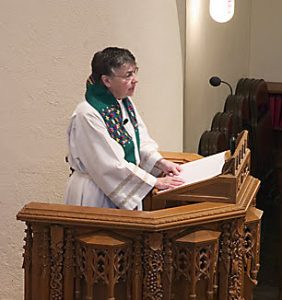125 years of Grace.




It all began with the school.
In 1896, several dozen families of St. John Lutheran Church in Forest Park, Illinois, opened a branch Lutheran school at Augusta and Belleforte, in northwest Oak Park. Harlem Avenue, the main north-south thoroughfare that linked the two towns, was not paved in those days, and attending the new school meant that students would not have to trudge through a mile of mud to get to class.


A new congregation named Grace.
The school flourished, and in 1902, the school families and others chartered a new Lutheran congregation in Oak Park, for which they chose the name Grace. In 1904, they erected a church structure next to the one-room schoolhouse, a brick building with a tall steeple that still stands today.
In 1922, Otto A. Geiseman was called to be pastor at Grace, and thus began an era of growth and outreach into the non-German, non-Lutheran surrounding community.


The move to River Forest.
A larger church and school building was dedicated in 1931. The building, in the English Gothic style, was designed by the architectural firm of Talmadge and Watson. It was erected on the corner of Division and Bonnie Brae, across Harlem Avenue in neighboring River Forest, adjacent to the campus of Concordia Teachers College (now Concordia University). The Rose window, installed in 1931, was designed by Charles Connick. Stained glass windows in the nave were created by Erhardt Stoettner, master craftsman and designer of stained glass windows for the T. C. Esser Studios in Milwaukee, Wisconsin. They were installed as donations were made and funds became available between 1942 and 1948. Despite the Depression and World War II, the congregation was debt-free by 1947. A new wing was added to the school in 1952.
The 1950s and 1960s were a time of steady growth for Grace. F. Dean Lueking, who had come to the congregation as an assistant pastor in 1954, became pastor in 1963, after the death of Pastor Geiseman. The church and school communities enjoyed a close relationship with Concordia, which is owned and operated by the Lutheran Church–Missouri Synod, the larger church body to which the Grace congregation belonged. Grace School served as the lab school for Concordia’s teacher education program, and many faculty members and their families were members at Grace.
Controversies in the Missouri Synod during the late 1960s and 1970s led to the congregation’s decision in September 1977 to leave the synod and become an independent Lutheran congregation.


Leadership through the years.
From the late 1940s through the 1980s, a series of assistant pastors served the congregation for two- or three-year terms. In 1990, the congregation called its first permanent associate pastor, Leon Rosenthal. Phyllis N. Kersten, the first woman pastor at Grace, served as associate pastor from 1996 until her retirement in 2008. Pastor Lueking retired in 1998, and Bruce K. Modahl served as senior pastor from 1998 through 2014. David R. Lyle was called to be Senior Pastor in 2015. Associate Pastors Lauren Dow Wegner and David W. Wegner served as associate pastors from 2016-2020. Troy Medlin was called to be associate pastor in 2020.
Through the years, God has blessed Grace with gifted leadership in other areas as well. Victor Waldschmidt served as principal of the school for 33 years. He was succeeded in 1980 by Gerald Koenig, who retired in 2000. The current Grace School principal is Dr. Taylor-Imani Gates. Paul Bouman came to Grace in 1953 as a teacher, organist, and choir director, and with Carl Schalk, founded the Bach Cantata Vesper Series in 1971. He retired in 1983 but continued to participate in Grace’s musical life as music director emeritus until his death in 2019. John Folkening served as music director from 1983 to 2000, followed by Jonathan Oblander. Michael D. Costello has served as cantor since 2008.


A new addition for a new century.
Expanding ministries and the changing needs of the church and school led the congregation to construct a substantial building addition, completed in 1999, which includes includes modern classrooms, a large gymnasium, a youth room for junior and senior high programs, meeting rooms, and office space. The remodeling of the old building added rehearsal space for the music program and upgraded Fellowship Hall from part-time gymnasium to full-time meeting space.
Grace’s constitution and governing structure call for wide participation from lay leadership. Many individuals serve on boards and committees and volunteer their time and talents in the church’s healing and teaching ministries and its many activities.
We look forward to a future in which the people of Grace, nourished by Word and sacrament, continue to witness to the good news of the Gospel in the congregation and in the community.
Additional resources
Grace Under Pressure, by F. Dean Lueking (Richmond, VA: Skipworth, 1979).
Lift High the Cross: A Century of Grace Evangelical Lutheran School, by A. G. Roeber (River Forest, IL: Grace Lutheran School Centennial Committee, 1995).
The Promise of Grace, by Martin Marty (Grand Rapids, MI: Eerdmans, 2005).
These books are available in the church library.
